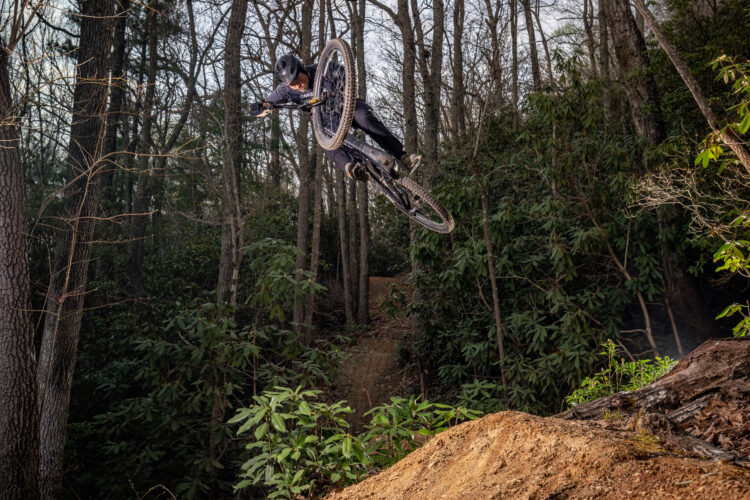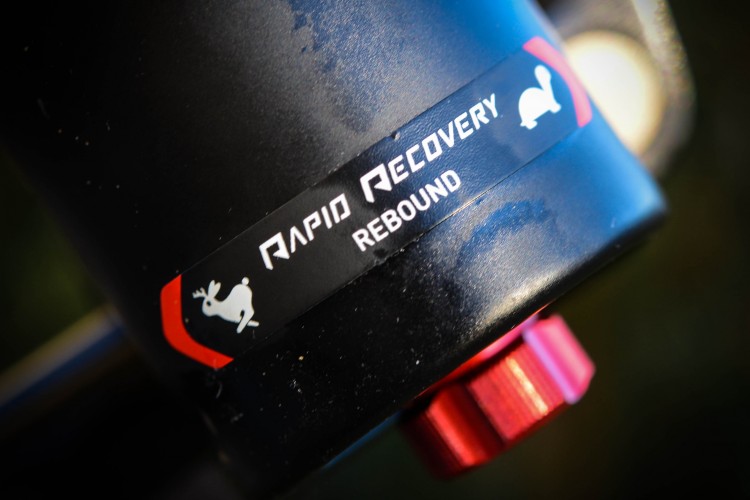
I’m not sure when the first time was I heard this statement, but it was probably at a bike shop and I think about it often on rides, especially if a friend points at the travel ring on my fork stanchion.
“You didn’t use much of your travel?”
The statement stirs up a few variables. Did I ride slowly? Is the trail not that exciting? Did I have my suspension setup wrong?
As someone who is testing different bikes and suspension products over the course of any given year, it’s often the latter, but you have to wonder: Should you be using all of your suspension travel on a ride? To find out, I connected with TJ Hansen, the racing and MTB manager at Öhlins. He regularly helps the world’s best mountain bikers dial in their shocks and forks and gave us some insight into the question.
I’ve heard this statement over the years that mountain bikers should use their full amount of suspension travel on every ride. Is that true?
I definitely think that you should not be scared of using the full travel. I’m a firm believer that you should be using the full travel, depending a little bit on your ride as well.
I mean, if you’re just gonna go pedaling and it’s super flat, no bumps, no G-outs or anything, maybe you shouldn’t be using the full travel. But how we look at it on the racing side, we always try to achieve that. All the athletes should use the full travel–100%
So if Finn Iles did a run down Mont St. Anne you’d expect to see his travel ring all the way at the top?
If it’s Loic Bruni or Ollie Davies, or a privateer, we’re trying to get them to use all travel. But in a controlled way. They shouldn’t fall through the stroke too easily. All athletes, if we talk racing here for a second, they still want to have the support in the pedals. They can’t dive too fast. They can’t blow through the stroke. It should be in a controlled way.
And that’s what we’re fine tuning with the pressures, fine tuning with spacers. Now we don’t have that system in our forks–for XC we do. But on our forks you can control that pressure from the outside and if we’re talking rear shocks then you start maybe fine tuning with low speed compression and high speed compression, depending a little bit on the circumstances.
I think what people also forget is that it’s a matter of taking care of the wheel movement right away. That’s what we strongly believe, and maybe some people think maybe our product is a little bit over-damped than others. But we strongly believe that you should take care of the wheel movement right away, so you don’t start accelerating too fast through the stroke. And that’s very tricky. It’s very tricky, because it’s a borderline of where that comfort and traction…it’s gonna be it’s a balance between the two. So that’s where you’re having all those days, at the races to fine tune those things. And try to go as fast as you can.

For the last 25% of your travel, what are the kinds of terrain you want to think about for using that? Drops, jumps, G-outs?
Yeah…the trickiest thing to to have on a course is when it’s fairly low speeds, like Val di Sole is a great example of that, with fairly low speeds, and you’re dropping big drops, into the ground.
And if you’re going to set up the bike for [handling] that, individual, that section of the track, it will be unrideable everywhere else. There, as a rider, you have to, consider…I’m maybe going to bottom here a little bit too hard, maybe I can take a different line, maybe I can do something different.
Those are the tricky situations, when you have segments like that. It can also be G-outs, like long G-outs and then if you’re hitting something during that G-out, and the bike wants to step away, not necessarily just going up, it can kick you or buck you in the straightway, those places are pretty tricky as well.
But, G-outs to the big drops, where you’re traveling fairly slow. Those are the tricky things.
And you and the athletes you work with it also find it challenging to completely optimize the suspension for a certain track?
Yeah. We have had locations this year where we, like Friday after qualifications we have done so many changes for the Saturday finals, it’s just crazy. But that’s why we’re there.

This is a little off topic, but do you find it hard to take input from athletes and get to a suspension setting that is suitable for them?
It’s tricky. For the big dogs. I mean, Finn and Loic, they pretty much know what they want, most of the times. But sometimes even they don’t really know what direction we need to go.
And for the privateers, maybe this comes also with experience that for doing this so long, you can ask them questions and they are answering your question without knowing that they actually answered it.
So you talk about how they maybe feel the bike is low or tall in those situations where they’re having issues and therefore you can say, maybe we try to go in this direction but also try to keep it simple.
As far as dialing suspension, do you recommend people start with sag and then go to rebound and compression rates?
Yes, it’s a combination of the two; compression and rebound…like 80% of the performance of your ride is to have the correct balance of the bike. So even at the World Cup levels, we have to start all over again (sometimes), and help (some riders) measure sag, make that dialed and then follow through with the correct pressure on the fork and, and start all over again, a little bit. And I mean, it’s very beneficial, because fairly easily, you can improve the bike quite a lot. And then you can start fine tuning your compression.
For someone with a less advanced fork or shock with simpler compression damping, are they limited in how much they can optimize suspension because of their damper?
You can come a long way. We have a lot of people coming to the [Öhlins] truck at races and a lot of them have their suspension fully open. Because they want to have it plusher or want to have more grip or want to have comfort over the chattery stuff and things like that. And we want to put everything back once again and take care of the wheel movement right away.
That means that we go back with the clicks, put it in a good position, whatever that is depending on the product, help them dial in sag, and you send them out and they come back and they’re like, “wow, I didn’t know what you did, but it’s amazing.”
A very good example of that–I wasn’t there, but a couple of years ago, Angel Suarez was using our products. And he was just lost. So he stopped by Loic’s mechanic and said, “Hey, nothing feels right,” and they’ve been trying to help the Öhlins riders around, so he puts the clicks back into it, closed the low speed compression a little bit more than normal, and everything. The guy ended up on the podium.
It’s crazy sometimes. So yes, to come back and answer your question, you can do a lot of things, even though with a simple suspension or whatever you have on your bike–make sure you have the correct sag, start with that, put the (settings) in a somewhat normal position, write it down somewhere, go out, ride and test and get the feel for it, you will come along along the way.

So in that event where someone is having trouble with their suspension, the best bet is to return to the factory settings and play with it from there?
It’s a good starting point. Then after that, we’re all individual…I’m this tall, this fat, hanging off the back all the time, scared to death of the bike, and then you, who is lighter. Of course, we need different setups.
Start with the right spring, and then you fine tune with clicks. And if the clicks are not enough, you go and see your service center, and they will help you out to go in the direction depending on where your clicks have been. And off you go.
What else should riders consider when setting up their suspension?
Once again, I can’t preach it too much: Don’t be scared to use your clicks. And try different pressures. Try different preloads if you have a coil. Just get a feel for it. There’s a lot of shim cowboys and forum racers out there. But make up your own mind and understand your bike, your suspension. You will have a such a better ride. Don’t listen so much to everybody else. Make up your own and investigate a little bit.
If that door is locked, then try the next door. I’ve also been doing this for way too long. I’m celebrating 25 years here at Öhlins next year, so and I’ve met so many shim cowboys out there who want to throw shims left and right and think that’s the answer to all the things but they forgot to get the basics of it.
And also, what’s the single biggest improvement you can do to a bike that has [X amount] of hours on it? Is it putting new seat or grips on? Maybe tires. But always keep your suspension fresh. Do a lower service. There’s videos on YouTube, get a little bit of oil and grease to have in your workshop, take your lowers off, service it and you will have a same thing there; you will have a better performing bike. And a much better ride.
Authors note: If you happen to have an Öhlins fork and need help setting it up, we have this guide here and there is info useful and relevant to other brands too.



















